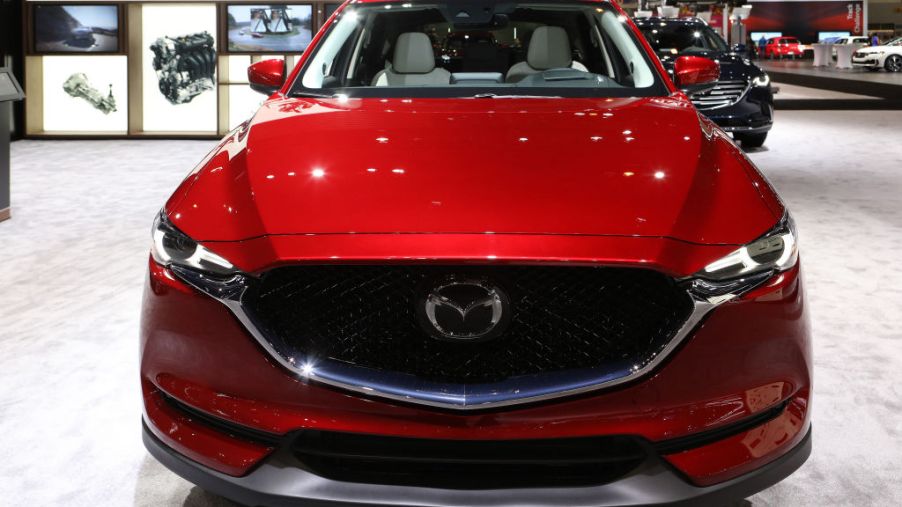
Mazda Somehow Made the CX-5 Better by Decreasing Its Fuel Economy
Mazda first released the CX-5 compact crossover for model year 2013, and it was redesigned for 2017. While in just its second generation, the Mazda CX-5 has offered four different engines over the years, with three currently available on the 2020 CX-5. As these engines have grown more powerful, the driving fun increases, but the fuel economy slightly decreases too.
Smaller engine, better fuel economy
The first-generation Mazda CX-5 in 2013 originally had a 2.0-liter four-cylinder engine matched with a six-speed automatic transmission or a manual transmission.
This small engine wasn’t that powerful, generating just 155 hp, but it did get 25 MPG combined in tests by Consumer Reports. The EPA rated it even better, at 28 MPG combined for the front-wheel drive and 27 MPG for the all-wheel drive version. The front-wheel-drive manual transmission version was rated for 29 MPG combined.
The small engine made a lot of noise when getting up to speed to merge into traffic. Unfortunately, that was really noticeable since there wasn’t much sound insulation. The smaller engine option was considered underpowered and eventually was discontinued.
Bigger engines, more fun for the Mazda CX-5
A new engine option quickly arrived, appearing for the 2014 model year, bringing 184 hp and faster acceleration. Later models of the first generation came with this more responsive 2.5-liter four-cylinder engine, which was able to achieve nearly the same fuel efficiency.
The EPA rated the fuel efficiency in 2014 at 27 MPG and 26 MPG overall for the front-wheel drive and all-wheel drive versions with this engine.
The smaller engine remained available throughout the first generation years, although only on the base Sport trim. With the arrival of the second-generation CX-5 for 2017, the smaller engine was dropped along with the manual transmission.
The 2.5-liter engine also got its horsepower increased by four hp to 187 hp. The new generation kept a similar appearance along with its engine and good handling, but it offered a better and quieter ride. Since some weight was added to create a quieter cabin for the second-generation CX-5, the fuel efficiency dropped just a hair.
A diesel engine
A diesel engine option was introduced during 2018, according to Consumer Reports. This 2.2-liter four-cylinder turbo-diesel produces 174 hp. It was created to offer performance more than fuel efficiency, but the EPA’s rating of the 2019 diesel engine was for 29 MPG combined for the front-wheel drive model and one less for the all-wheel drive.
This makes it the most fuel-efficient of the three current options. This engine is an option on the 2020 CX-5 Signature trim, and it’s now only available with all-wheel drive.
Turbo engine
A turbo option arrived for 2019 and 2020: the 2.5-liter four-cylinder turbo, which produces 250 hp with premium gas and 227 hp with regular gas. Available on the 2020 CX-5 Signature and Grand Touring Reserve trim levels, it provides what Consumer Reports calls “effortless acceleration.” This engine is rated for 24 MPG combined on the all-wheel-drive model. (It isn’t available with front-wheel drive.)
The 2020 Mazda CX-5
Consumer Reports ranked the 2020 CX-5 first on its list of compact SUVs. Consumer Reports gushes about the CX-5’s ride, saying it has “one of the most comfortable in its segment.”
It provides “athletic” handling and “responsive steering.” Car and Driver calls the 2020 CX-5 “a winner” and put it on their 2020 10Best list.
The CX-5 has five trims for buyers to pick from: Sport, Touring, Grand Touring, Grand Touring Reserve, and Signature. All-wheel drive is available on the bottom three trims and standard on the Grand Touring Reserve and Signature.
With fuel efficiency ratings between 24 MPG and 29 MPG combined for its currently available engines, the 2020 Mazda CX-5 forces buyers to choose between fuel efficiency and power. It’s a good thing that all versions of the CX-5 are fun to drive.


